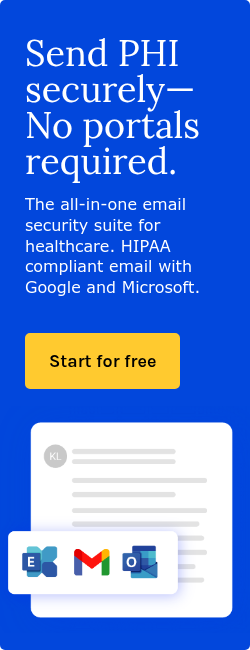
“The HIPAA Privacy Rule establishes national standards to protect individuals' medical records and other individually identifiable health information (collectively defined as “protected health information”) and applies to health plans, health care clearinghouses, and those health care providers that conduct certain health care transactions electronically,” writes the U.S. Department of Health and Human Services (HHS).
Creating a HIPAA compliant workplace environment is more than a regulatory requirement, it's a foundational commitment to protecting patient privacy and maintaining trust in the healthcare system. With the digitization of health records and healthcare operations increasingly relying on technology, ensuring the confidentiality, integrity, and availability of protected health information (PHI) must be made a priority.
What it entails
Creating a HIPAA compliant workplace environment requires a comprehensive, multi-layered approach that spans policies, training, and technology. It also involves implementing administrative, physical, and technical safeguards to ensure that PHI is accessed, used, and stored securely. From limiting access to sensitive information and using encrypted communication tools to training staff and conducting regular risk assessments, every element of the workplace must be aligned with HIPAA’s standards to maintain compliance and protect patient trust.
See also: HIPAA Compliant Email: The Definitive Guide (2025 Update)
Administrative safeguards
Administrative safeguards are the backbone of HIPAA compliance, comprising of “over half of the HIPAA Security requirements.” According to the HHS, “As with all the standards in this rule, compliance with the security controls already in place, an accurate and thorough risk analysis, and a series of documented solutions derived from a number of factors unique to each covered entity.” These include the creation and enforcement of privacy and security policies, assigning responsibility to a designated privacy officer or security official, and conducting risk assessments to identify vulnerabilities.
Some key administrative safeguards include:
- Employee training: All staff members who interact with PHI must undergo initial and ongoing training to understand HIPAA requirements and their responsibilities. This training should cover topics like password protection, identifying malicious software, and proper handling of patient data.
- Risk analysis and management: Regular risk assessments help identify threats and vulnerabilities to the confidentiality, integrity, and availability of PHI. Based on the findings, appropriate risk management strategies must be developed and implemented.
- Contingency planning: HIPAA requires healthcare organizations to prepare for emergencies. This includes having a data backup plan, disaster recovery plan, and emergency mode operation plan to ensure the continuation of critical operations.
- Designated HIPAA officers: Organizations must designate a privacy officer and a security official responsible for developing, implementing, and overseeing HIPAA-related policies and practices.
Go deeper: A deep dive into HIPAA's administrative safeguards
Physical safeguards
“The standards are another line of defense (adding to the Security Rule’s administrative and
technical safeguards) for protecting EPHI,” says the HHS. Physical safeguards are the physical measures put in place to protect electronic systems and the buildings where PHI is stored from unauthorized physical access.
Essential physical safeguards include:
- Controlled facility access: Only authorized personnel should have access to areas where PHI is stored, whether electronically or on paper. Facilities must use access controls like key cards, visitor logs, or security cameras.
- Workstation security: Computers and devices used to access PHI must be secured when not in use. This includes locking screens, limiting access, and ensuring devices are located in secure areas.
- Device and media controls: Organizations must manage the receipt, removal, and disposal of hardware and electronic media that contain PHI. This includes procedures for proper disposal (e.g., degaussing or physical destruction) and secure reuse of devices.
Go deeper: What physical safeguards are required by HIPAA?
Technical safeguards
According to the HIPAA Security Rule Technical safeguards, “No specific requirements for types of technology to implement are identified. The Rule allows a covered entity to use any security measures that allows it reasonably and appropriately to implement the standards and implementation specifications. A covered entity must determine which security measures and specific technology.” Some examples include:
- Access control: Implement unique user IDs, role-based access, and emergency access procedures to ensure that only authorized individuals can access PHI.
- Encryption and decryption: Encrypting ePHI both in transit and at rest protects it from unauthorized access, especially when data is shared over public or unsecured networks.
- Audit controls: Maintain hardware, software, and procedural mechanisms to record and monitor access to systems containing ePHI. These audit trails can be critical in identifying security incidents or breaches.
- Automatic logoff: Configure systems to automatically log users off after a period of inactivity to prevent unauthorized access.
Policies
The HIPAA Security Rule mandates the implementation of administrative safeguards, which encompass comprehensive policies and procedures designed to manage the selection, development, implementation, and maintenance of security measures to protect electronic PHI. These policies establish clear guidelines on how PHI is accessed, used, and disclosed within an organization. They also delineate the responsibilities of workforce members in safeguarding PHI, thereby fostering a culture of compliance and accountability.
Policies should cover areas such as:
- Permitted uses and disclosures of PHI
- Employee responsibilities for securing data
- Breach notification and response plans
- Remote work and bring-your-own-device (BYOD) policies
- Data retention and destruction procedures
Well-documented and regularly updated policies ensure consistency and accountability, helping create a culture of compliance throughout the organization.
Read also: How to develop HIPAA compliance policies and procedures
Training
According to the HIPAA Security Rule Administrative safeguards, “A covered entity must train all members of its workforce on the policies and procedures with respect to protected health information required.” This should be done “as necessary and appropriate for the members of the workforce to carry out their functions within the covered entity.”
In April 2025, the U.S. Department of Health and Human Services (HHS) proposed updates to the HIPAA Security Rule aimed at strengthening employee training across healthcare organizations. These changes reflect a growing concern over cyber threats, particularly social engineering attacks like phishing, which exploit human behavior rather than technical vulnerabilities. The proposal calls for more frequent, role-specific training that equips staff with the skills to recognize and respond to such threats. By prioritizing ongoing education, the HHS underscores the critical role of a well-informed workforce in safeguarding protected health information (PHI).
Technology
Although HIPAA does not dictate specific technologies, the right tools can achieve and maintain compliance. These include:
- Secure communication tools: Use HIPAA compliant email, texting, and video conferencing platforms for internal and external communication involving PHI.
- Mobile device management (MDM): If employees access PHI on mobile devices, MDM solutions can enforce encryption, remote wipe capabilities, and secure app usage.
- Data loss prevention (DLP): DLP tools can detect and block attempts to send PHI via unauthorized channels.
Building a culture of compliance
From top-level executives to frontline staff, everyone must understand their role in safeguarding PHI. Here are some final tips:
- Foster open communication: Encourage staff to ask questions and report concerns without fear of retaliation. HHS advises, “Written confidentiality and non-retaliation policies should be developed and distributed to all employees to encourage communication and the reporting of incidents of potential fraud.” Such implementations ensure that potential issues are identified and addressed promptly, reducing the risk of violations.
- Perform regular audits: Routine internal audits help catch and correct non-compliance before it escalates.
- Stay informed: HIPAA requirements may evolve. Keep up with updates from the HHS and other regulatory bodies.
FAQS
What is HIPAA and who does it apply to?
HIPAA is the Health Insurance Portability and Accountability Act. It is a U.S. law that protects the privacy and security of individuals’ health information. It applies to covered entities (like healthcare providers, health plans, and healthcare clearinghouses) and business associates who handle protected health information (PHI) on their behalf.
Go deeper: What is HIPAA?
What are the penalties for non-compliance with HIPAA?
Penalties range from civil fines ($141 to $71,146 per violation) to criminal charges, depending on the nature and severity of the violation. Willful neglect and repeated violations often result in higher penalties.
Can employees be held personally responsible for HIPAA violations?
Yes. While employers are usually held accountable, individual employees may also face disciplinary actions or, in severe cases, criminal penalties for intentional HIPAA violations.
Subscribe to Paubox Weekly
Every Friday we'll bring you the most important news from Paubox. Our aim is to make you smarter, faster.




